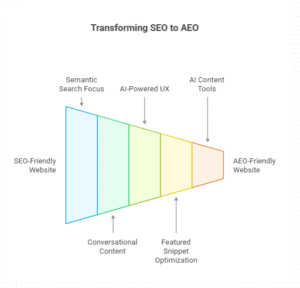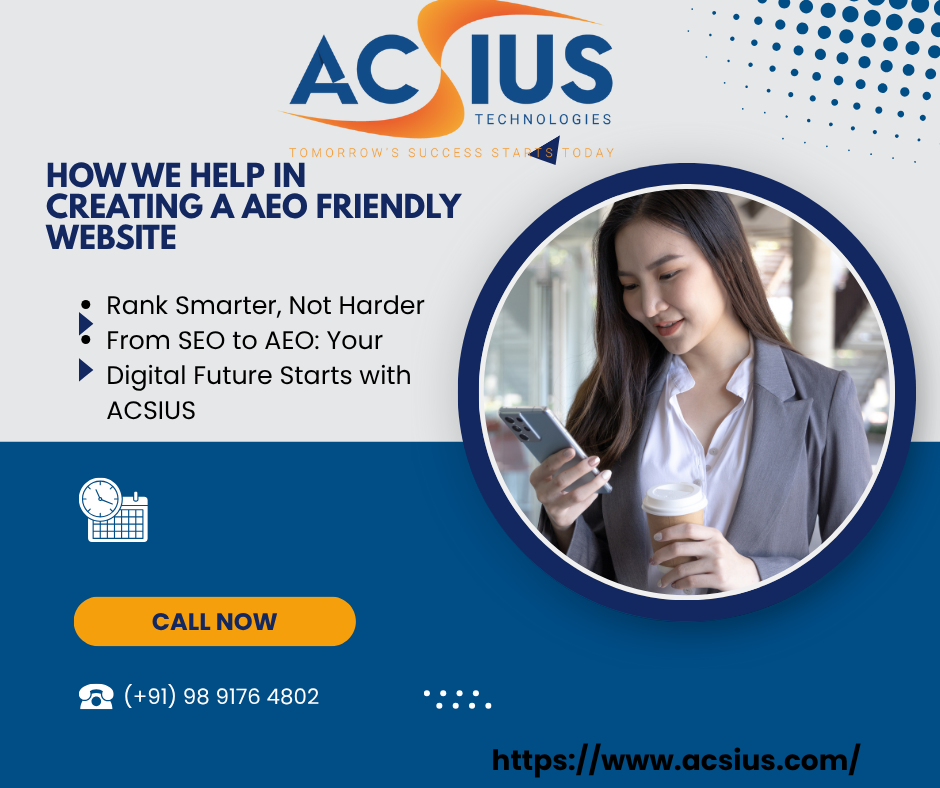How To Upgrade A Website From SEO Friendly To AEO Friendly In 2026
As digital marketing continues to evolve, businesses must stay ahead of the curve by adopting new strategies. AEO (AI-Optimized Experience) is a concept that’s gaining traction as search engines increasingly use AI models like Large Language Models (LLMs) to rank websites. If your website is optimized for traditional SEO, it may not be sufficient for future search engine algorithms. Here, we’ll explore how to upgrade your website from being SEO-friendly to AEO-friendly, ensuring it performs well in AI-driven search results.
-
Understand the Shift from Keywords to Semantic Search
SEO has traditionally focused on the use of keywords and backlinks. However, with AI-driven search, there’s a shift towards semantic search. This means search engines like Google are now trying to understand the intent behind a user’s query rather than just matching keywords. To make your website AEO-friendly, you need to focus on contextual relevance rather than merely inserting specific keywords.
For example, instead of using just “digital marketing tips,” you should create content around “how small businesses can leverage digital marketing to boost sales.” This phrase captures the intent of users looking for actionable advice and can help you rank better with AI search algorithms.
-
Focus on High-Quality, Conversational Content
AEO prioritizes content that mirrors human-like conversations. With Large Language Models (LLMs), search engines aim to provide results that feel more natural and intuitive to the user. This is why creating conversational, engaging content is key to improving your website’s AEO.
One way to achieve this is by using natural language that addresses your target audience’s needs directly. Instead of stiff, robotic text, use a tone that’s casual and friendly, similar to how a person might ask or answer a question in real life. For instance, if your target audience is looking for help with website optimization, try to craft content around questions like: “What are the easiest ways to make my website faster?” or “How can I improve my website’s user experience without hiring an expert?”
Search engines using AI models will reward websites that provide these long-tail conversational keywords like “how to increase user retention on my e-commerce site” over generic ones like “increase website traffic.”
-
Improve User Experience with AI-Powered Tools
Search engines have become more focused on user experience (UX), with AEO placing a stronger emphasis on AI-powered UX elements. To move beyond just SEO, you’ll need to implement tools that predict and respond to user needs, offering a tailored browsing experience.
For example, personalization algorithms that change the content or layout based on the visitor’s behavior can enhance engagement. Additionally, chatbots, powered by AI, can provide immediate answers to user queries, helping to keep them on your site longer and reduce bounce rates. This aligns with AEO’s emphasis on real-time interactions and providing instant value to users.
Make sure your website is mobile-responsive, fast, and easy to navigate. These are basic user experience factors that influence rankings in both SEO and AEO algorithms.
-
Optimize for Featured Snippets and Structured Data
A crucial factor for AEO is optimizing your website for featured snippets. LLMs in search engines pull directly from the featured snippets (often appearing at the top of the search results) to provide concise answers to user queries. To make your website AEO-friendly, target featured snippets by using question-based headings, bullet points, or numbered lists to present your content in a clear and structured way.
Additionally, implement structured data markup (Schema.org) to help search engines understand the content on your page more effectively. By using rich snippets, such as reviews, ratings, or pricing, search engines can show more relevant information directly in the search results, which helps boost visibility.
Example: If you’re running a product review blog, you can use structured data for product reviews to allow Google to show the rating of your products directly in search results, making your site more likely to attract clicks.
-
Leverage AI Content Optimization Tools
To stay ahead in the AEO game, it’s essential to use AI-based content optimization tools. These tools, such as surfer SEO or Copy.ai, can analyze your content and suggest ways to improve its readability, relevance, and keyword usage.
For instance, using AI tools, you can find related keywords that help your content rank for semantic search terms. The tools will suggest LSI keywords (Latent Semantic Indexing) that are contextually related to your topic. This helps ensure your content is fully optimized for AEO algorithms, which care about content relevancy rather than just keyword density.
Moreover, AI tools help you spot trends and gaps in your content, allowing you to fine-tune it for both SEO and AEO. By optimizing your content for AI readability, you’ll be able to improve your search rankings and visibility significantly.

Conclusion
Upgrading your website from SEO-friendly to AEO-friendly is an important step to ensure your business stays relevant in the age of AI-powered search engines. By focusing on semantic search, enhancing user experience with AI tools, and optimizing for featured snippets, you can make your website more appealing to AI-driven models. Remember, content that provides value, is easy to navigate, and answers user queries in a conversational tone will always perform better in AEO ranking algorithms.
Real Example:
Let’s say you run a blog about healthy eating. In traditional SEO, you might target keywords like “healthy recipes” or “nutritious meals.” These are good keywords to rank for, but with AEO, the search engines are shifting toward understanding the user intent behind the search query.
For example, if someone types in “best low-calorie meals for weight loss,” Google is trying to understand the meaning behind this phrase—not just the words. Instead of ranking your page because it mentions the term “healthy eating” over and over, Google will now favor content that aligns with the user’s specific question: “What are low-calorie meals that help with weight loss?”
In this case, to make your content AEO-friendly, you would optimize your article to be more contextual and cover not just healthy recipes but also meal planning for weight loss, which directly addresses the user’s question. You could use a phrase like, “Low-calorie meals to aid weight loss and boost metabolism” in your article’s title or subheadings, which is a more semantic, long-tail keyword that matches the user’s intent.
How ACSIUS Can Help Your Business Rank in AI Search Engines
As the world of AI-powered search engines continues to evolve, staying ahead of the curve is crucial for maintaining a competitive edge in digital marketing. ACSIUS, as an advanced digital marketing agency, is well-equipped to help you optimize your website for AI-optimized experience (AEO) and make sure that it ranks highly in AI-driven search results.
Here’s how ACSIUS can help you take your website from SEO-friendly to AEO-friendly and ensure that your content performs well in AI search engines:
AI-Powered Content Optimization
At ACSIUS, we utilize cutting-edge AI tools to optimize your content in a way that appeals directly to Large Language Models (LLMs) like Google’s BERT and RankBrain. These AI models focus more on context and user intent rather than just keyword density.
How we help:
- We analyze search intent and use semantic keywords to ensure your content is contextually relevant to what users are searching for.
- We incorporate LSI keywords (Latent Semantic Indexing) to ensure your content is seen as authoritative and closely related to the search query.
- We craft long-tail conversational keywords that mimic natural language, improving the chances of ranking in voice search or featured snippets.
By focusing on the human element in search, we can ensure your website’s content resonates with AI algorithms, making it easier to rank.


